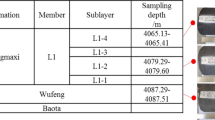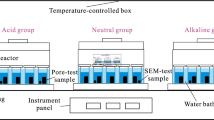Abstract
Due to the need of breaking the formation during hydraulic fracturing, the fracturing fluid is usually weakly acidic or weakly basic, and the contact of the fracturing fluid with shale leads to significant alterations in its mechanical properties. However, the mechanical characteristics of shale using fracturing fluids of different pH still require further investigations. In this study, fracturing fluids with pH values of 6, 7 and 8 are considered to perform shale soaking experiments. The mechanical properties of shale after soaking for 15 days to 12 months, are tested using uniaxial compressive strength tests. The microscale variations of shale during imbibition are recorded by X-ray diffraction (XRD) tests and electron microscopy (SEM) tests, together with EDS analysis. The experimental results demonstrate that after 12 months of imbibition in acid, neutral and alkaline fluids, the strength and Young’s modulus of shales decrease by almost 28.9%, 24.3%, 32.2% and 32.2%, 36.1%, 46.8%, respectively. During the imbibition, these values show decreasing–increasing–decreasing trends. The SEM and EDS results show that a large amount of pyrite and clay minerals are dissolved in the reaction process. In the soaking process, the pH of fracturing fluid highly decreases in the first 15 days of immersion, and then gradually increases. The water–rock reaction and hydration expansion cause the changes of the microstructure of shale and the pH of fracturing fluids. They finally result in macroscopic mechanical properties changes. It can be deduced from the long-term test results that the initial pH value of the fracturing fluid has a small impact on the mechanical properties of shale. The obtained results are helpful to better understand the influence of hydraulic fracturing on the mechanical characteristics of shale, and to optimize the shale gas recovery.
Highlights
-
The mechanical properties of shales after long term immersion in different pH fracturing fluids are investigated.
-
During prolonged immersion, the strength and Young's modulus show decreasing-increasing-decreasing trends.
-
Extensive water-rock reactions occur during the immersion process, resulting in significant decrease in the pH of the fracturing fluids.










Similar content being viewed by others
References
Al-Bazali TM (2011) The consequences of using concentrated salt solutions for mitigating wellbore instability in shales. J Petrol Sci Eng 80(1):94–101. https://doi.org/10.1016/j.petrol.2011.10.005
Al-Bazali TM, Al-Mudh’hi S, Chenevert ME (2011) An experimental investigation of the impact of diffusion osmosis and chemical osmosis on the stability of shales. Petrol Sci Technol 29(3):312–323
Al-Maamori HMS, El Naggar MH, Micic S, Lo KY (2018) Influence of water and lubricant fluids on peak strength of Queenston shale from southern Ontario. Can Geotech J 55(4):455–476. https://doi.org/10.1139/cgj-2016-0238
Bai J, Kang Y, Chen Z, You L, Chen M, Li X (2020a) Changes in retained fracturing fluid properties and their effect on shale mechanical properties. J Nat Gas Sci Eng 75:1–12
Bai JJ, Kang YL, Chen ZX, You LJ, Chen MJ, Li XC (2020b) Changes in retained fracturing fluid properties and their effect on shale mechanical properties. J Nat Gas Sci Eng. https://doi.org/10.1016/j.jngse.2020.103163
Chen X, Eichhubl P, Olson JE, Dewers TA (2020a) Salinity, pH, and temperature controls on fracture mechanical properties of three shales and their implications for fracture growth in chemically reactive fluid environments. Geomech Energy Environ 21:1–12
Chen X, Eichhubl P, Olson JE, Dewers TA (2019a) Effect of water on fracture mechanical properties of shales. J Geophys Res Solid Earth 124(3):2428–2444
Chen XF, Eichhubl P, Olson JE, Dewers TA (2020b) Salinity, pH, and temperature controls on fracture mechanical properties of three shales and their implications for fracture growth in chemically reactive fluid environments. Geomech Energy Environ. https://doi.org/10.1016/j.gete.2019.100140
Chen XF, Eichhubl P, Olson JE, Dewers TA (2019b) Effect of water on fracture mechanical properties of shales. J Geophys Res Solid Earth 124(3):2428–2444. https://doi.org/10.1029/2018jb016479
Deng T, Zhan JW, Huang M, Fan FT (2014) Experimental study on disintegration characteristics of red bed soft rock-argillaceous shale in acid and alkali environment. J Eng Geol 22(02):238–243
Ewy RT (2014) Shale swelling/shrinkage and water content change due to imposed suction and due to direct brine contact. Acta Geotech 9(5):869–886. https://doi.org/10.1007/s11440-013-0297-5
Ghanbari E, Dehghanpour H (2016) The fate of fracturing water: a field and simulation study. Fuel 163:282–294. https://doi.org/10.1016/j.fuel.2015.09.040
Gupta V, Ahmed I (2007) The effect of pH of water and mineralogical properties on the slake durability (degradability) of different rocks from the Lesser Himalaya, India. Eng Geol 95(3–4):79–87. https://doi.org/10.1016/j.enggeo.2007.09.004
Huang T, Cao LN, Cai JJ, Xu P (2019) Experimental investigation on rock structure and chemical properties of hard brittle shale under different drilling fluids. J Petrol Sci Eng. https://doi.org/10.1016/j.petrol.2019.106185
Huh Y, Edmond JM (1998) On the interpretation of the oceanic variations in 87 Sr/ 86 Sr as recorded in marine limestones. Proc Indian Acad Sci Earth Planet Sci 107(4):1–14
Karakul H (2018) Effects of drilling fluids on the strength properties of clay-bearing rocks. Arab J Geosci 11(16):1–11
Li H, Lai BT, Lin SH (2016a) Shale mechanical properties influence factors overview and experimental investigation on water content effects. J Sustain Energy Eng 3(4):78–85
Li X, Feng Z, Han G, Elsworth D, Marone C, Saffer D, Cheon D (2016b) Breakdown pressure and fracture surface morphology of hydraulic fracturing in shale with H2O, CO2 and N2. Geomech Geophys Geo-Energy Geo-Resour 2:63–76
Lin C, Kang YL, You LJ, Yan XP, Chen Q (2019) Effect of fluid exposure on mechanical properties of organic-rich shale and field applications. In: Qu Z, Lin J (eds) Proceedings of the international field exploration and development conference 2017. Springer Series in geomechanics and geoengineering, pp 1746–1760. https://doi.org/10.1007/978-981-10-7560-5_158
Liu SY (2019) Damage characteristics of oil shale under the action of acidizing fracturing fluid. Jilin University, Changchun
Lu C, Guo J, Xiao S, Zheng Y, Yin C (2019) Effect of acid treatment on microstructure and mechanical properties of shale. Nat Gas Ind 39(10):59–67
Lyu Q, Long X, Pg R, Tan J, Zhou J, Wang Z, Luo W (2018a) A laboratory study of geomechanical characteristics of black shales after sub-critical/super-critical CO2+ brine saturation. Geomech Geophys Geo-Energy Geo-Resour 4(2):141–156
Lyu Q, Long X, Ranjith PG, Tan J, Kang Y (2018b) Experimental investigation on the mechanical behaviours of a low-clay shale under water-based fluids. Eng Geol 233:124–138
Lyu Q, Long X, Ranjith PG, Tan J, Kang Y, Wang Z (2018c) Experimental investigation on the mechanical properties of a low-clay shale with different adsorption times in sub-/super-critical CO2. Energy 147:1288–1298
Lyu Q, Tan J, Li L, Ju Y, Busch A, Wood DA, Ranjith PG, Middleton R, Shu B, Hu C (2021) The role of supercritical carbon dioxide for recovery of shale gas and sequestration in gas shale reservoirs. Energy Environ Sci 14(8):4203–4227
Ma T, Chen P, Zhao J (2016) Overview on vertical and directional drilling technologies for the exploration and exploitation of deep petroleum resources. Geomech Geophys Geo-Energy Geo-Resour 2(4):365–395
Minardi A, Ferrari A, Ewy R, Laloui L (2018) The impact of the volumetric swelling behavior on the water uptake of gas shale. J Nat Gas Sci Eng 49:132–144
Van Oort E (1997) Physico-chemical stabilization of shales. In: international symposium on oilfield chemistry, 1997. OnePetro
Padin A, Torcuk MA, Katsuki D, Kazemi H, Tutuncu AN (2018) Experimental and theoretical study of water and solute transport in organic-rich carbonate mudrocks. SPE J 23(03):704–718
Petrakov D, Kupavykh K, Kupavykh A (2020) The effect of fluid saturation on the elastic–plastic properties of oil reservoir rocks. Curved Layered Struct 7(1):29–34
Pluymakers A, Ougier-Simonin A, Barnhoorn A (2021) Ion-species in pore fluids with opposite effects on limestone fracturing. Geomech Energy Environ 26:100233
Rimstidt JD, Vaughan DJ (2003) Pyrite oxidation: a state-of-the-art assessment of the reaction mechanism. Geochim Cosmochim Acta 67(5):873–880
Roshan H, Andersen MS, Rutlidge H, Marjo CE, Acworth RI (2016) Investigation of the kinetics of water uptake into partially saturated shales. Water Resour Res 52(4):2420–2438. https://doi.org/10.1002/2015wr017786
Roy DG, Singh TN, Kodikara J, Das R (2017) Effect of water saturation on the fracture and mechanical properties of sedimentary rocks. Rock Mech Rock Eng 50(10):2585–2600
Rybacki E, Reinicke A, Meier T, Makasi M, Dresen G (2015) What controls the mechanical properties of shale rocks? Part I: strength and Young’s modulus. J Petrol Sci Eng 135:702–722. https://doi.org/10.1016/j.petrol.2015.10.028
Song MG (2016) Mechanism of wellbore instability eroded by organic shale lye. Southwest University of Petroleum, Chengdu
Tan J, Hu C, Lyu Q, Feng G, Chen S (2022) Experimental investigation on the effects of different fracturing fluids on shale surface morphology. J Petrol Sci Eng 212:110356
Torcuk MA, Uzun O, Padin A, Kazemi H (2019) Impact of chemical osmosis on brine imbibition and hydrocarbon recovery in liquid-rich shale reservoirs. In: SPE annual technical conference and exhibition, 2019. OnePetro
Van Oort E (2003) On the physical and chemical stability of shales. J Petrol Sci Eng 38(3–4):213–235
Wu W, Sharma MM (2017) Acid fracturing in shales: effect of dilute acid on properties and pore structure of shale. SPE Prod Oper 32(1):51–63. https://doi.org/10.2118/173390-pa
Xing HZ, Wu G, Dehkhoda S, Ranjith PG, Zhang QB (2019) Fracture and mechanical characteristics of CO2-saturated sandstone at extreme loading conditions. Int J Rock Mech Min Sci 117:132–141. https://doi.org/10.1016/j.ijrmms.2019.03.025
Yan CL, Deng JG, Cheng YF, Li ML, Feng YC, Li XR (2017a) Mechanical properties of gas shale during drilling operations. Rock Mech Rock Eng 50(7):1753–1765. https://doi.org/10.1007/s00603-017-1203-5
Yan CL, Deng JG, Cheng YF, Li ML, Feng YC, Li XR (2017b) Mechanical properties of gas shale during drilling operations. Rock Mech Rock Eng 50(7):1753–1765
Yan J, Zhang X, Liang C, Hao AL, WU B, (2019) Study on the effect of drilling fluid additives on the compressive strength of shale in Changning area. Drill Prod Technol 42(03):13–16
Yang L, Ge H, Shen Y, Zhang J, Yan W, Wu S, Tang X (2015) Imbibition inducing tensile fractures and its influence on in-situ stress analyses: a case study of shale gas drilling. J Nat Gas Sci Eng 26:927–939. https://doi.org/10.1016/j.jngse.2015.07.028
Yu YF, Kang YL, You LJ, Chen Q, Yang B (2013) Alkali erosion: a new mechanism of shale wellbore instability. Petrol J 34(05):983–988
Zhong Y, Kuru E, Zhang H, Kuang J, She J (2019) Effect of fracturing fluid/shale rock interaction on the rock physical and mechanical properties, the proppant embedment depth and the fracture conductivity. Springer, Vienna, p 52(4)
Acknowledgements
The authors acknowledge the financial support from the National Natural Science Foundation of China (Grant nos. 41872151, 42002160), the Innovation-Driven Project of Central South University (Grant no. 502501005), and the Natural Science Foundation of Hunan Province, China (Grant no. 2020JJ5705).
Author information
Authors and Affiliations
Corresponding author
Ethics declarations
Conflict of interest
On behalf of all authors, the corresponding author states that there is no conflict of interest.
Additional information
Publisher's Note
Springer Nature remains neutral with regard to jurisdictional claims in published maps and institutional affiliations.
Rights and permissions
About this article
Cite this article
Lyu, Q., Wang, K., Hu, C. et al. Experimental Study on the Mechanical Properties of Shale After Long-term of Immersion in Fracturing Fluids with Different pH. Rock Mech Rock Eng 55, 5047–5061 (2022). https://doi.org/10.1007/s00603-022-02918-4
Received:
Accepted:
Published:
Issue Date:
DOI: https://doi.org/10.1007/s00603-022-02918-4




